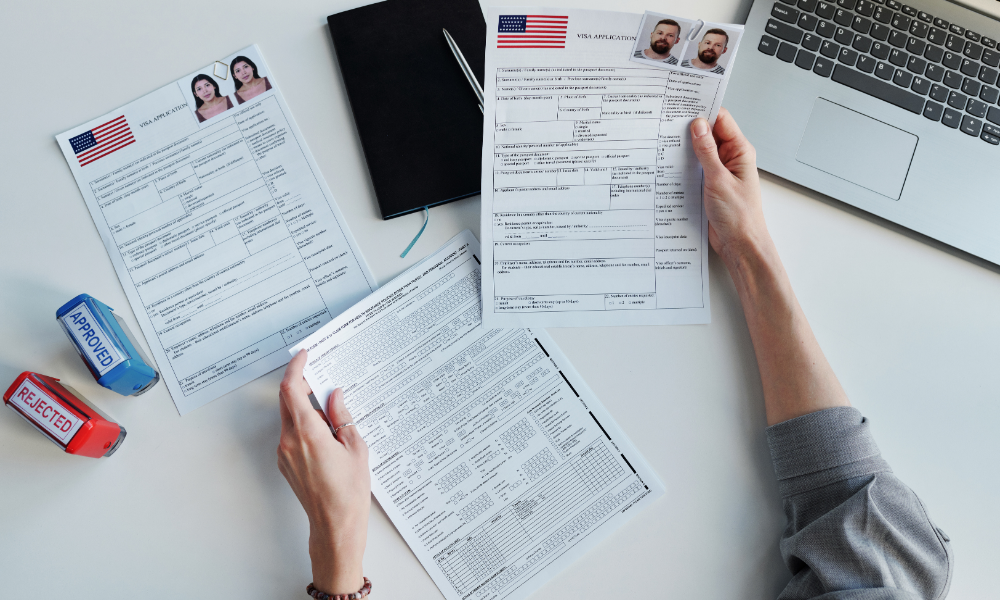Table of Contents
- The Hidden Bottleneck: Malaysia’s Employment Pass
- The Three Main Work Pass Options In Malaysia
- Step-By-Step Breakdown (Using Real Hexa Process Data)
- Real Timeline Snapshots (From Hexa Cases)
- Why Setting Up A Local Entity In Malaysia Isn’t Always The Smartest Move
- What It Actually Takes To Set Up In Malaysia
- What Is An EOR?
- What You Get When You Use An EOR
- How a Top Malaysian Bank Hired 60 Specialists Without Adding a Single HR Headcount
- Frequently Asked Questions — Work Visas In Malaysia
- Let’s Get Your Team Into Malaysia — The Smart Way
You did everything right.
You won the deal.
You built the plan.
Your team’s ready to roll.
And the client in Malaysia?
They want your best people on the ground — yesterday.
So you pick your top engineer.
Your most trusted project manager.
You’ve got the flights. The accommodation. The budget.
And then…you hit immigration.
That’s when everything stops.
“You need to advertise on MyFutureJobs first.”
“You’ll have to wait 30 days before you can apply for the Employment Pass.”
“Is the job title classified under ESD yet?”
“We can’t submit unless the Hiring Outcome Report is approved by PERKESO.”
Suddenly, your launch window evaporates.
Nobody knows how long it’ll really take.
Nobody’s giving you straight answers.
And every “guide” you find online was either written in 2019… or copied from another site.
You’re not trying to cheat the system.
You just want to do things right — and fast.
You want your team deployed legally, with full compliance, and zero surprises.
But instead, it feels like Malaysia’s work visa system was designed by someone who never had to deliver on a project deadline.
You’re not alone.
Every month, we hear from companies across India, the UK, the U.S., and Singapore saying the same thing:
“We just need to get our people in — we didn’t expect it to be this hard.”
The good news?
There’s a way to do this right, without delays, drama, or regulatory blind spots.
And in this guide, we’re going to walk you through it — step by step.
No fluff. No outdated advice.
Just the real roadmap to getting your foreign team into Malaysia — legally, quickly, and without setting up a local entity if you’re not ready.
ALSO READ: How To Get A Work Visa In The Philippines In 2025 (Without Setting Up A Local Entity)
The Pain Most Companies Feel
It’s never the sales.
It’s never the product.
It’s never the client.
It’s always the permits.
You’re not losing deals.
You’re losing time — and time is where momentum goes to die.
Here’s how it usually plays out:
You’ve signed the contract.
You’ve picked your deployment team.
They’ve packed their bags.
Then suddenly, your HR team gets hit with this:
“We need to post the job on MyFutureJobs for 30 days first.”
“We need to submit a Hiring Outcome Report to PERKESO.”
“We need to classify the position on the ESD portal.”
“Oh — and if the salary’s under RM15,000, none of this can be skipped.”
Your brain goes numb.
You’re not launching a company — you’re just trying to put one or two engineers on-site.
But suddenly it feels like you’re building a local HR department just to get them through immigration.
Meanwhile, the client is waiting. The deadline is ticking.
And your team — the people you trust to deliver — are stuck in visa limbo.

The Hidden Bottleneck: Malaysia’s Employment Pass
Most companies assume that hiring in Malaysia is plug-and-play. It’s not.
To legally work in Malaysia for more than 3 months, your expat staff need an Employment Pass (EP).
And getting that EP approved? It’s not just about submitting a few documents.
It’s about checking all the invisible boxes first:
- Has the job been advertised on MyFutureJobs for the full 30-day cycle?
- Was the Hiring Outcome Report submitted and approved?
- Is the job title already registered in the ESD portal?
- Is the salary over or under RM15,000 (and do different rules apply)?
- Does your company even qualify to hire expats?
Each question is a landmine.
Each delay restarts the clock.
And nobody tells you that until you’re already in the system.
The worst part?
Most of this process is completely invisible to first-time applicants.
It’s not just slow — it’s confusing.
It’s not just paperwork — it’s a compliance trap.
And for companies without a full-blown HR-legal-immigration team in Malaysia, it’s overwhelming.
But it doesn’t have to be.
In the next section, we’ll break down exactly how the Employment Pass works,
what the government actually wants to see, and how to avoid the delays that derail so many well-intentioned global deployments.
Understanding Malaysia’s Work Visa Landscape
Most people think “work visa” is just a line item on a checklist.
It’s not.
It’s a filter.
It’s a test.
It’s the government’s way of asking:
“Do you really need to bring this person here?”
And if you don’t know which visa to apply for — or why —
you’re already at risk of delay, denial, or total confusion.
Let’s fix that.
The Three Main Work Pass Options in Malaysia
Malaysia doesn’t have a one-size-fits-all work visa.
It has a layered system — designed to vet both the employee and the employer.
Here’s what matters most:
For long-term, professional employment (the default visa for expats).
- Use this if:
- Your staff will work in Malaysia for more than 3 months
- They are in a skilled or managerial role
- They are employed by a registered entity in Malaysia
Validity: 1–5 years
Issued By: Immigration Department via ESD (Expatriate Services Division)
Key Requirements:
- Employer must be ESD-registered
- MyFutureJobs ad (if salary < RM15,000/month)
- Hiring Outcome Report (HOR)
- Approval from PERKESO
Note: This is the visa we’ll go deep on in the next section. It’s what 90% of expat deployments rely on.
2. Professional Visit Pass (PVP)
For short-term, non-contractual assignments.
- Use this if:
- Your staff is not directly employed by a Malaysian company
- They’re here for training, auditing, installation, or consulting
- The stay is under 12 months
Example: An engineer installing proprietary equipment for a foreign vendor.
Restrictions:
- No local employment contract
- Sponsorship required
- Renewals limited
3. Dependent & Long-Term Social Visit Passes
These aren’t for employment, but you’ll need them if you’re bringing families, spouses, or kids along.
Which One Do You Need?
Here’s the blunt truth:
If you’re hiring foreign staff to work in Malaysia full-time — or even mid-term —
you’ll almost always need the Employment Pass (EP).
It’s not optional.
It’s not flexible.
It’s the backbone of Malaysia’s foreign talent framework — and also where most companies run into trouble.
Why?
Because getting it approved isn’t just about your employee.
It’s about your company, your process, and how well you navigate the systems behind it.
That’s where things get tricky.
That’s what we’ll cover next.
Inside the Employment Pass Process — What You Need to Know
Most companies treat the Employment Pass like a form.
Fill it out.
Upload a few documents.
Get a stamp. Done.
That’s how you get rejected.
Because the Employment Pass process in Malaysia isn’t a form — it’s a funnel.
Each step is a filter.
And if you miss one, you don’t move forward.
Let’s walk through it the way the government actually sees it — not the way the blog posts pretend it works.

Step-by-Step Breakdown (Using Real Hexa Process Data)
Step 1: Document Vetting (2 working days)
- Before anything happens, we review every file:
- Passport (14-month validity + 6 blank pages)
- Education certs (translated if needed)
- CV with job gaps explained
- Job description, salary, contract duration, marital status
Miss one requirement? We don’t move forward.
Step 2: MyFutureJobs Ad (30 calendar days)
(Required if salary is under RM15,000/month)
You can’t skip this.
Even if the candidate is perfect.
Even if the role is urgent.
The Ministry of Human Resources wants to see you gave local talent a fair chance.
- 30 days of ad posting
- Interviews conducted
- Hiring Outcome Report (HOR) prepared
HOR must explain why no local was hired.
This report is submitted to PERKESO for approval. Takes another 7–14 working days.
Step 3: Job Title Validation in ESD Portal (5–10 working days)
If your job title isn’t listed in the ESD system, you’ll need to create a new role, align it with the CV and job description, and wait for manual approval.
No alignment = no submission.
Step 4: EP Application Submission (14 working days)
Now you can apply.
The application goes through immigration review via the ESD platform.
- If there are no errors, approvals typically take 2 weeks.
- If rejected or returned, the entire clock resets.
One typo can cost you 2 more weeks.
Step 5: Employment Pass Endorsement (3–5 working days)
Once approved, the applicant receives a VDR Letter (Visa with Reference).
Then comes the physical visa sticker.
Options:
- Endorse at Hexa office
- Endorse at KLIA/ESC upon arrival
The final step: issuance of the i-Kad — Malaysia’s official expat ID.

Real Timeline Snapshots (from Hexa cases)
| Scenario | Time to Approval |
|---|---|
| Salary > RM15,000 | ~30 working days (no MyFutureJobs/HOR required) |
| Salary < RM15,000 | ~60 working days (with ad + HOR process) |
| With job title registration or document returns | Add 7–14 days each |
Where Most Companies Go Wrong
- Submitting documents with inconsistent job titles
- Skipping MyFutureJobs when it’s required
- Assuming translation isn’t necessary
- Underestimating how long HOR approval takes
- Trying to rush without buffer time
One return = 2 weeks lost.
One assumption = total reset.
This is why you need more than a checklist.
You need a partner who’s seen the landmines — and walked teams through them clean.
Next, we’ll talk about what happens if you don’t have a local entity… and why that’s not the blocker most people think it is.
Why Setting Up a Local Entity in Malaysia Isn’t Always the Smartest Move
You’ve probably heard this advice already:
“If you want to hire expats in Malaysia, just set up your own entity.”
And technically?
They’re right.
Legally, you need a Malaysian entity to sponsor Employment Passes.
But here’s what they don’t tell you:
Setting up an entity isn’t a first step. It’s a final step.
It’s what you do after the market proves itself — not while you’re still figuring it out.
What It Actually Takes to Set Up in Malaysia
Let’s say you go the traditional route. Here’s what’s waiting for you:
- Company incorporation through SSM (Suruhanjaya Syarikat Malaysia)
- Appointing at least one local director
- Registered office address
- Paid-up capital (min RM500,000+ for certain visa categories)
- Tax registration, accounting setup, SST compliance
- Monthly filings, payroll setup, HR documentation
- ESD registration before you can even begin sponsoring expat visas
- Ongoing compliance even if you stop operations temporarily
And no — this isn’t just paperwork.
It’s money.
It’s time.
It’s risk.
And it’s not what you signed up for if all you want to do is get one project manager on the ground to deliver.
What You Risk by Setting Up Too Soon
- Wasted capital if the market doesn’t scale as planned
- Delayed go-live because of incorporation and immigration backlog
- Compliance exposure from local laws you haven’t mastered
- Diverted leadership bandwidth into accounting, legal, and tax
Setting up a Malaysian entity to deploy one or two employees is like building a hotel to host a 3-day meeting.
There’s a smarter way.
In the next section, we’ll show you how companies are entering Malaysia faster, cheaper, and safer — without a local entity, without hiring local lawyers, and without touching a stack of immigration forms.
It’s called an Employer of Record.
And it might be the most important strategy you’ve never heard of.
The Better Way — Using an EOR to Sponsor the Work Visa
Here’s the truth nobody told you:
You don’t need to set up a Malaysian entity to send someone there.
You just need someone who already has one — and can legally host your employee.
That’s exactly what an Employer of Record (EOR) does.
ALSO READ: The Impact Of Employer Of Record For Global Outsourcing In 2025

What Is an EOR?
An EOR is a fully registered, fully compliant local company that hires employees on your behalf.
They handle:
- Work visa sponsorship
- Payroll and taxes
- Government reporting
- Mandatory contributions (EPF, SOCSO, EIS)
- i-Kad issuance
- Compliance with Malaysian labor laws
Your team remains your team — but on paper, they’re employed by the EOR.
You get speed, simplicity, and zero compliance risk.
What You Get When You Use an EOR
- Legal work visa sponsorship without setting up an entity
- Full Employment Pass processing, including MyFutureJobs, HOR, and ESD navigation
- Fast onboarding with predictable timelines
- One monthly invoice — no HR admin, no payroll mess, no tax surprises
- Real-time compliance without lifting a finger
What You Avoid
- Delays from incorporation
- Upfront capital investment
- Entity maintenance and filings
- Navigating local bureaucracy blind
- Hiring a local HR and finance team before your first hire even lands
Common Use Cases for an EOR in Malaysia
- You’ve won a project and need to deploy talent fast
- You’re testing the Malaysian market before going all-in
- You want to hire someone locally but don’t have a company set up
- You’re waiting for your own entity to be approved, and need a temporary solution
What About Control?
We get this question a lot.
“If Hexa is the legal employer, do we lose control?”
Absolutely not.
You still:
- Select and approve who to hire
- Set the salary, role, and KPIs
- Manage and supervise their day-to-day work
- Own the relationship with your client
We simply handle the infrastructure — so you don’t have to.
Think of us as the foundation beneath your feet — not the roof over your head.
What Happens When You’re Ready to Set Up Your Own Entity?
Simple.
We help you transition your employees from our EOR platform into your own Malaysian company — cleanly, compliantly, and without disruption.
It’s part of our “enter, scale, own” philosophy:
Get in fast.
Build your base.
Take full control when the time is right.
ALSO READ: ‘I’m A Startup. How Can I Have My Own Human Resources And Finance Team?’
Case Study
How a Top Malaysian Bank Hired 60 Specialists Without Adding a Single HR Headcount
When one of Malaysia’s most prominent banks launched a massive cloud infrastructure migration, they knew the stakes were high.
Data security.
Customer uptime.
Millions in transformation budgets.
A hard deadline.
What they didn’t have… was time.
The Problem: Speed Meets Scale
They needed to bring in over 60 highly skilled resources — developers, analysts, cloud architects, migration engineers. And they needed them fast.
But their internal HR team was already stretched. They couldn’t afford the time, cost, or complexity of managing:
- Recruitment
- Onboarding
- Payroll and benefits
- Contracts
- Immigration for expat hires
- Performance issues
- And everything in between
“This isn’t our core strength,” they admitted. “We just need the right people in the seats — and we don’t want to build an HR army to do it.”
The Curveball: They Also Needed Expat Talent
Some of the cloud roles required specialised foreign expertise.
But sponsoring Employment Passes?
Interviewing international candidates?
Coordinating relocation, visa timelines, and compliance?
“We’d never done this before — and we didn’t have time to learn.”
The Solution: Hexa’s EOR and Talent Delivery Model
That’s when they called us.
Hexa stepped in as their Employer of Record and full-service recruitment partner.
Here’s what we handled:
- Recruited and onboarded all 60 resources — end-to-end
- Sponsored and secured Employment Passes for 5 expatriates
- Managed payroll, benefits, contracts, and HR admin
- Acted as the legal employer on paper — while the client maintained full performance control
The Results: Agility, Control, and Zero HR Overhead
- The client only had to manage performance
- Bad hires? Replaced in days — without internal escalation
- Top talent? Absorbed permanently into their workforce
- Every process — from payroll to compliance — handled seamlessly by Hexa
- No need to expand their internal HR or legal teams
- Total control, zero overhead
“It’s like we were running a lean, agile tech startup — inside a legacy banking structure,” said one of their delivery managers.
The Takeaway
The project was a success on all fronts — and not just because the cloud migration was delivered.
It worked because the client had the right people, at the right time, with zero friction.
No HR overload.
No visa nightmares.
No 60-page internal proposals to justify new headcount.
Just execution.
- This is the power of an EOR model when done right.
- Ideal for large corporates who need to move fast
- Ideal for SMBs who don’t want to build back-office overhead before they prove the market
- Ideal for anyone who’s tired of paperwork standing in the way of progress
ALSO READ: ‘We’ve Business Development To Expand Abroad; How Can I Build My Remote Team?’

Frequently Asked Questions — Work Visas in Malaysia
Can I get a work visa in Malaysia without setting up a local company?
Not directly — but yes, with an EOR.
The Malaysian government requires a registered local entity to sponsor Employment Passes.
If you don’t have one, you can legally hire through an Employer of Record (EOR) like Hexa.
We act as the sponsor and legal employer — you manage the work.
How long does it take to get an Employment Pass approved in Malaysia?
- If the salary is over RM15,000/month: ~30 working days
- If under RM15,000 (requires MyFutureJobs & HOR): ~60 working days
- Add time for job title registration, document revisions, or returned applications
Using Hexa means you don’t deal with the process — we handle it all.
What is MyFutureJobs and why does it delay my application?
MyFutureJobs is a mandatory government portal where roles must be advertised for 30 days (for roles paying < RM15,000/month).
This is followed by interviews and a Hiring Outcome Report (HOR) submitted to PERKESO.
No ad = no visa.
We handle this for you when acting as EOR.
Do I still manage my employees if Hexa is the legal employer?
Absolutely.
You:
- Choose who to hire
- Set responsibilities, KPIs, and compensation
- Manage them daily
We handle the backend: contracts, payroll, visa compliance, and HR admin.
What happens if the candidate isn’t a good fit?
You tell us — and we replace them.
One of the biggest advantages of EOR + talent delivery is speed of correction.
You’re not stuck in bureaucratic deadlock.
What’s the difference between an Employment Pass and a Professional Visit Pass?
| Employment Pass | Professional Visit Pass |
|---|---|
| Long-term (1–5 years) | Short-term (up to 12 months) |
| Direct employment in Malaysia | Not employed by a Malaysian entity |
| Requires ESD registration | More limited activities |
| Common for full-time expat staff | Ideal for training, audit, install roles |
What if we decide to set up our own entity later?
Great. We’ll help you do that — and transition the talent from Hexa to your company.
You don’t lose continuity.
You don’t lose compliance.
You don’t start from scratch.
That’s part of our “enter, scale, own” model.
Are there risks to using an EOR?
Only if you pick the wrong one.
With Hexa, your talent is:
- Legally sponsored under a compliant local entity
- Properly taxed and reported
- Protected under Malaysian employment law
- Covered for visa renewals and terminations
No loopholes. No grey areas. Just clean execution.
Go Global Without Getting Stuck
You’re not trying to cut corners.
You’re not trying to break the rules.
You’re just trying to move fast, do it right, and deliver results — without dragging your company through months of red tape and regulation you never signed up for.
And that’s the part no one tells you about international expansion:
It’s not the growth that’s hard.
It’s the paperwork.
The clients are ready.
The talent is ready.
You’re ready.
But the system?
It wasn’t built for speed. It wasn’t built for you.
That’s why smart companies don’t fight the system — they work around it.
Legally. Compliantly. Strategically.
Whether you’re deploying two engineers or building an entire offshore delivery team, you don’t need to become an expert in MyFutureJobs, PERKESO, or visa endorsements.
You just need a partner who already is.
That’s what Hexa is built for.
We’ve helped banks, SaaS firms, consulting companies, and startups enter Malaysia, deliver fast, and grow without getting stuck.
Now it’s your turn.
Let’s Get Your Team into Malaysia — The Smart Way
You don’t need a 20-slide internal proposal.
You don’t need three months of legal prep.
You don’t need a local entity — yet.
You just need to get your people on the ground.
Let’s make it easy.
Whether you’re exploring options, ready to move, or just need a sanity check on your current process — we’re here to help you move forward.






